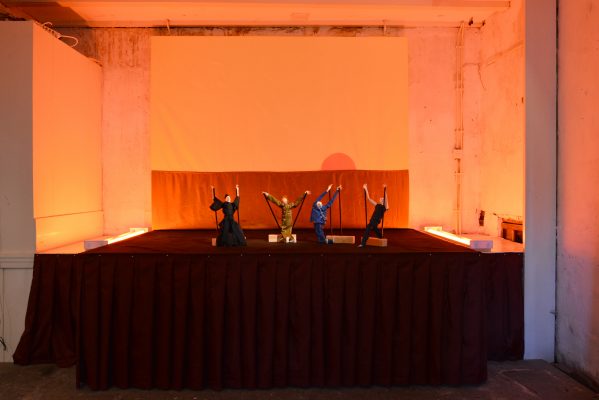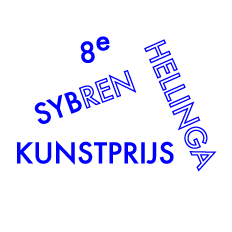17 October 2016
Interview with Eric Peter
Menno Vuister

Menno Vuister: You did a year of Art History at Utrecht University. How did you move from Art History to being an artist?
Eric Peter: I think my choice for Art History was partly influenced by my environment. I went to a gymnasium, a form of pre-university education, and the expectation was that you would go to university. I never actually looked at an art academy. The one thing that bugged me at university was that people seemed to rely so much on book knowledge. I was really into anthropology at the time and had hoped to find more of that in my studies. I was especially interested in the person behind the artist. Later, I met a lot of people that attended the art academy, and I decided to switch to the academy and focus on photography. As it turned out, my work was way too ‘autonomous’ for the curriculum, and I switched to performance art.
MV: Your interest in anthropology is baked into the fabric of your work. Where does this interest come from?
EP: I grew up in Dordrecht, an island in the Dutch Bible Belt. Even though life in Dordrecht is freer than in some surrounding towns, it is still oppressive. Anthropology was an escape for me into this world with completely different ideas and perceptions. It allowed me to explore other cultures, different customs and different time periods, and this really helped me to put things in perspective. That’s what spurred my interest. A couple of years ago, I realised that my grandparents’ Indian influence also played a role in this. Their house was filled with stuffed crocodiles, Kelims, Batik and Wajang dolls. It was a magical place for a child.
MV: Your work shows a yearning for cohesion and interconnectedness. For something you could call relational. How does this compare to the making process?
EP: Familiar Strangers: Conversations on the Near Future (2016) is a particularly good example of this. I like my work to spark questions on certain worldviews, current affairs or sentiment in society. But not in a dogmatic way. When I started with performance as a medium, I did everything myself. That created a big focus on me as an individual, which really was not important for the meaning of the work. I therefore started to involve others. Later, those people gained a much more active role, like in Familiar Strangers. I find it important to actively engage in a dialogue. Before, they were merely passive actors.
MV: At the academy, one often talks about finding your form; about finding the medium that expresses your ideas in the most fitting way. Where did the idea originate that performance was the medium for you?
EP: I think this goes back to the classical anthropological images I know from my youth. I’ve always been intrigued by how people connect and interact during certain dances and rituals. What I like about performance is that it reacts to a certain moment and to the people present at that time. Some might call this theatrical, but to me it feels natural. It also shows in my photography, and it’s the reason why I’m not particularly interested in painting. Though, I am currently decorating a few items with paint.
MV: Many young artists seem inclined to take a political or societal stance, or look for an engaging topic to prove the significance of art to society. How do you relate to this?
EP: It crosses my mind from time to time, but even before I started making art, I enjoyed playing devils advocate. I’ve always wanted to highlight that different perspective to encourage people to think. Some artists produce work that is both interesting and activist in nature, but which lacks any aesthetic. That’s not for me. What’s more important to me is that something is beautiful and aesthetically pleasing while conveying something substantial. I also don’t ask myself whether something is of more value simply because it’s politically or socially oriented. I just try to do what I want and address what I deem important.
MV: Aesthetics is clearly a prerequisite for your artistic practice. How do you change your ideas and research into something aesthetic?
EP: Sometimes the image you have in your mind suddenly coincides with an idea or research. Often this happens very organically. During my residencies at Vasl Artist’s Collective in Pakistan and The Unifiedfield in the Philippines (both in 2015), for example, I wrote down a few random word combinations. When I saw them again in my journal these words became names of characters. And that’s how I started to write a theatre play. In the end, research often transforms very intuitively into an image. Or I perform, as it were, with the material. In my studio, I then loose myself in a kind of ritual or performance in which the material plays a role. I pour information into myself and all images that flow from that are saturated with it.
MV: Let’s move on to Kunsthuis SYB. How did you become acquainted with SYB?
EP: Ever since my third year at the academy I wanted to do a residency at Kunsthuis SYB. I told myself that I would do that when I felt ready. I also heard about SYB from Rory Pilgrim and Jasper Griepink, whose work is in keeping with mine. So, I have played around with the idea for some years now. Then I saw the open call [for the Sybren Hellinga Kunstprijs, Ed.] and thought: “Well, let’s give it go.”
MV: Have you ever submitted work in this way before?
EP: Yes, I always keep my eyes out for open calls to get exposure.
MV: Do you see open calls as a good way for young artist to showcase their work and get exposure?
EP: Yes, I think so. Especially because they make you write about your work. I noticed my self-reflection, expressing myself in words and budgeting improved because of it. It is also good to introduce new work outside of your direct network. Though, I’m not sure if it is always the best way of doing it. There are also many opportunistic initiatives that, unlike Kunsthuis SYB, are only out to make money at the expense of (young) artists.
MV: Alongside fours other nominees, you will exhibit your work at Kunsthuis SYB. Any plans yet on what you would like to display?
EP: I’d really like to show a project I’ve been working on, a puppet show. But I don’t want to rush it. I also don’t want to screen the videos from Familiar Stranger again. So, I’m thinking of an installation that marks the first steps of the project: a version that shows the current stadium of the play entitled Generous Government and the Triad of Sorrows.
